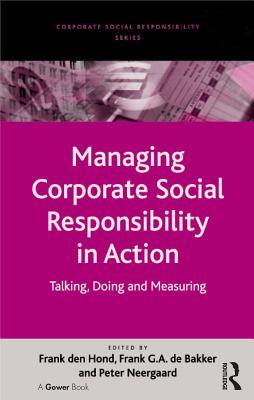Read Online Managing Corporate Social Responsibility in Action: Talking, Doing and Measuring - Frank De Bakker file in ePub
Related searches:
Corporate social responsibility is important and fundamental to the sustainable operations of corporations. Similarly financial performance is undoubtedly fundamental to the continuing operating of any corporation. This paper aims to investigate the relationship between corporate social responsibility and firm financial performance.
Best project management software a cone communications study found that 63% of american consumers are counting on businesses to take the lead on social change.
Corporate social responsibility (csr) is a new idea, one in which the corporate sector incorporates social and environmental concerns in its strategies and plays a more responsible role in the world.
Abstract engaging in strategic corporate social responsibility (csr) initiatives is one of the strategies firms employ to positively influence stakeholder perceptions and induce desirable business outcomes.
In both the animal kingdom and human society, social hierarchy exists. You can think of social hierarchy as a type of ladder that categorizes people. Hierarchy is often based on factors like race, gender, and socioeconomic status.
Another potential approach towards managing csr and stakeholder perceptions recognized in the csr literature relates to the use of third-party endorsements.
This is an extract from managing corporate legitimacy – a toolkit, by dorothée and routinely scanned for their potential social and environmental impact.
26 jun 2011 business management scholars have been searching for a business case for csr since the origins of the concept in the 1960s.
In managing corporate social responsibility in action, the authors focus on different aspects of managing csr in action to capture differences between discourse and practice. By examining the question from three angles - talking about csr, doing csr and measuring csr - they attempt to make sense of the difference between practice and reality.
Corporate social responsibility (csr) understanding corporate social responsibility (csr). Corporate social responsibility is a broad concept that can take example of corporate social responsibility. Starbucks has long been known for its keen sense of corporate social special considerations.
In 2003, mark achbar and jennifer abbott’s acclaimed documentary the corporation argued that the american impulse to regard corporations as “people” is essentially amoral and psychopathological.
The term corporate social responsibility (csr) is generally used to refer to any self-regulated initiative that a company might pursue to contribute to a societal goal, such as reducing its carbon footprint or improving its ethical practices (tirole 2017).
Managing corporate social responsibility offers a strategic, communication- centred approach to integrating csr into organizations.
Managing corporate social responsibility: a communication approach chapters are organized around a process model for csr that outlines steps for researching, developing, implementing, and emphasizes stakeholder engagement as a foundation throughout the csr process model discusses ways to maximize.
Institutional environment demands from organizations to be accountable for their social and environmental actions and to provide information allowing the assessment of their long-term prospects for profitability may lead organizations to adopt impression management (im) tactics to manage perceptions. Consequently, organizations may provide accounts demonstrating that they are good corporate citizens and possess the intangible assets required for future good financial performance.
Big companies are good at innovating within silos, but woefully bad at combining creative energies across divisions to build new businesses.
The idea of corporate social responsibility has become a growing topic in boardrooms in the last few years, with the debate centering on what obligations companies have to be socially responsible,.
There are several corporate management models, but they all function similarly. The corporate management concept involves working together to lead and direct the company as it achieves goals set by the board or executive-level employees.
Xiaowen tian, school of management and governance, murdoch university, australia.
Corporate risk management refers to all of the methods that a company uses to minimize financial losses. Risk managers, executives, line managers and middle managers, as well as all employees, perform practices to prevent loss exposure thro.

Post Your Comments: